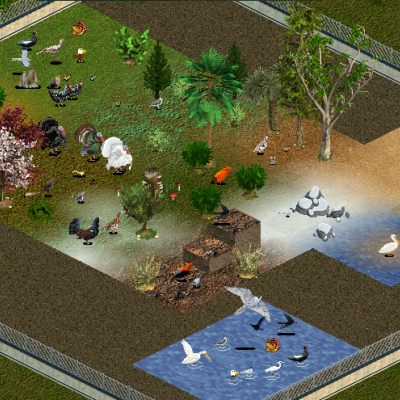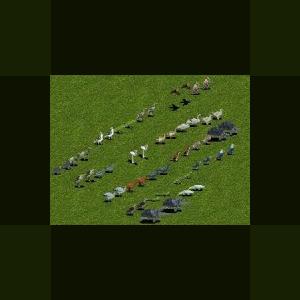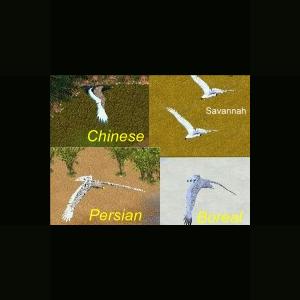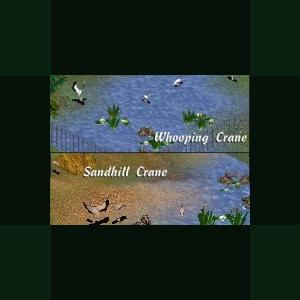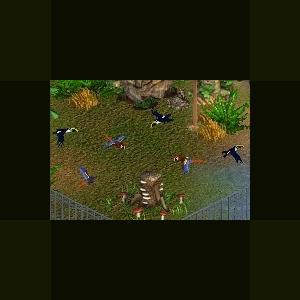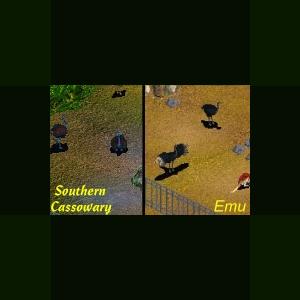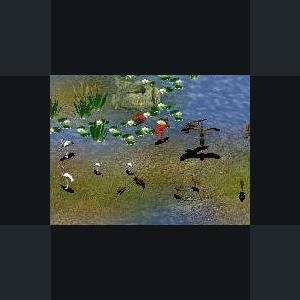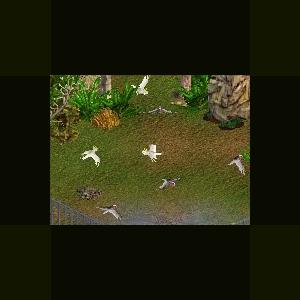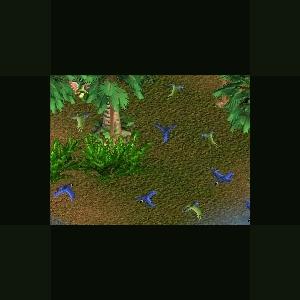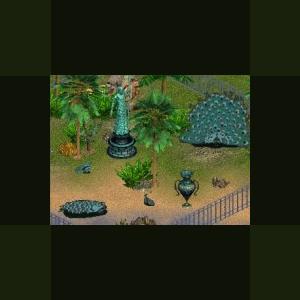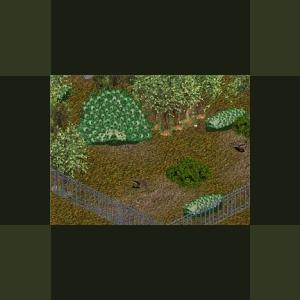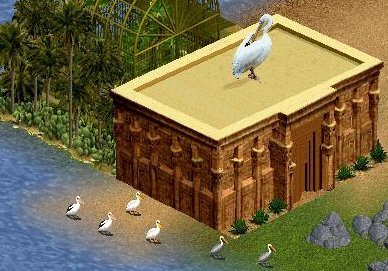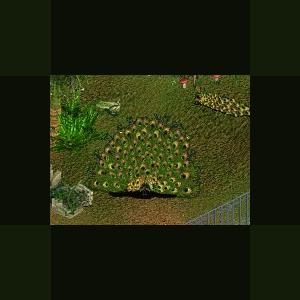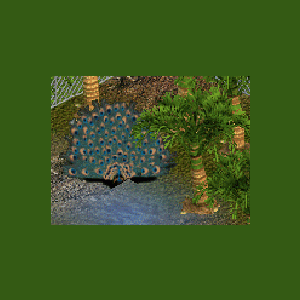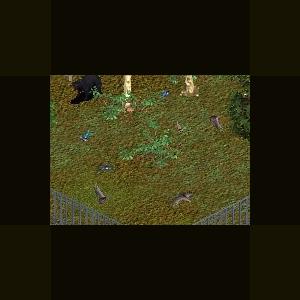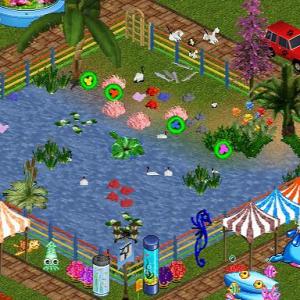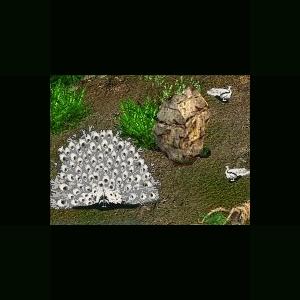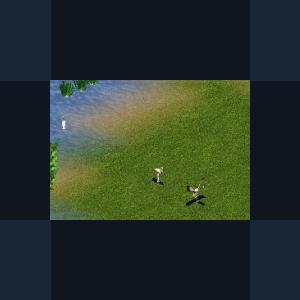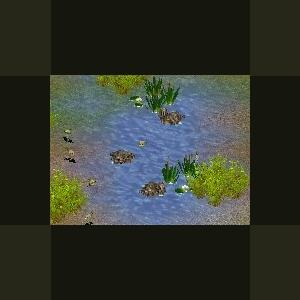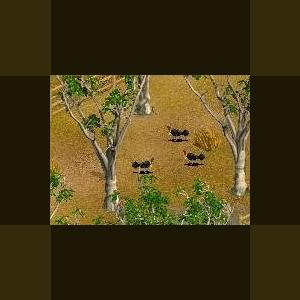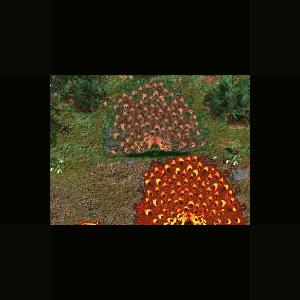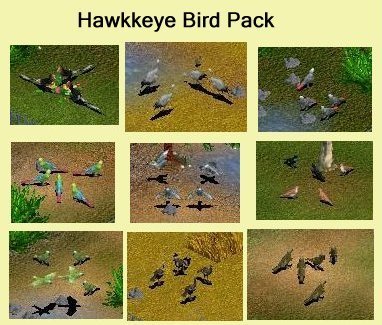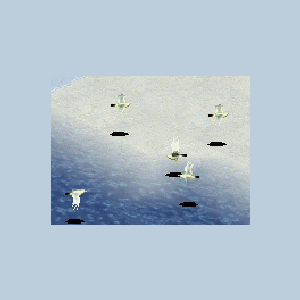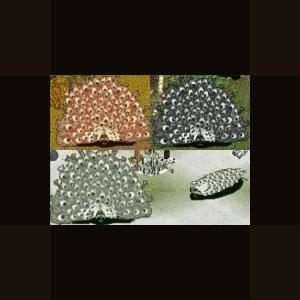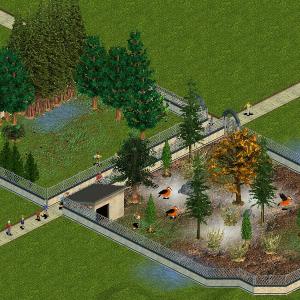Birds
Creatures on the wing
65 files
-
Birds - Part One by William
By William
Updated by Cricket on November 27, 2015:
A newer version has been attached. Although these may seem ok in-game, more work still needs to be done to ensure that they won't crash the game.
Various birds and other animals to use on your zoos
Contents:
Grassland (11):
Great white egret
Shih-tzu
Hen harrier
Muscovy duck
Red-legged seriema
Isa
Pidgeotto
Barn swallow
Yorkshire terrier
Deciduous forest (7):
Turkey
White turkey
Black turkey
Lyrebird
Reeves' pheasant
Baltimore oriole
Cuckoo
Coniferous forest (2):
Osprey
Bohemian waxwing
Boreal forest (1):
Capercaillie
Rainfores (1):
Guianan cock-of-the-rock
Scrub (3):
Chukar partridge
Koala
California quail
Highland (5):
Gray starling
Swift
Clark's nutcracker
Andean cock-of-the-rock
Rock pigeon
Tundra (1):
Arctic tern
Desert (6):
Great kiskadee
Peregrine falcon
Budgerigar
Cockatiel
Cactus wren
Desert finch
Many (1):
Pigeon
Aquatic (1):
Pelican
515 downloads
Updated
-
Mascarene Animal Pack by And 1
By Guest
The Mascarene Animals Pack contains 26 new animals of the Islands Mauritius, Reunion and Rodrigues.
Updated 2010-11-21
Just to save space with less in zip and smaller image.
Nothing new.
718 downloads
Updated
-
Rocs by Ghirin
By Guest
All four of the great mythical birds by Ghirin in one zip file. Also includes a combined ztd for your convenience.
Chinese Roc:
The roc (also known as the rukh) is a mythical bird that resembles an enormous eagle. The roc is so large and strong that it is able to lift adult elephants off of the ground, then send them back to earth to their deaths. Tales of rocs have been described in both the writings of Marco Polo and the voyages of Sinbad.
The roc of China is the most colorful of the roc species.
Reference:
www.wikipedia.org
Boreal Roc:
The roc (also known as the rukh) is a mythical bird that resembles an enormous eagle. The roc is so large and strong that it is able to lift adult elephants off of the ground, then send them back to earth to their deaths. Tales of rocs have been described in both the writings of Marco Polo and the voyages of Sinbad.
The boreal roc lives in the artic regions and enjoys hunting musk ox and caribou.
Reference:
www.wikipedia.org
Persian Roc:
The roc (also known as the rukh) is a mythical bird that resembles an enormous eagle. The roc is so large and strong that it is able to lift adult elephants off of the ground, then send them back to earth to their deaths. Tales of rocs have been described in both the writings of Marco Polo and the voyages of Sinbad.
The Persian roc is the largest of the roc species and is found in southern Eurasia.
Reference:
www.wikipedia.org
Savannah Roc:
The roc (also known as the rukh) is a mythical bird that resembles an enormous eagle. The roc is so large and strong that it is able to lift adult elephants off of the ground, then send them back to earth to their deaths. Tales of rocs have been described in both the writings of Marco Polo and the voyages of Sinbad.
The savannah roc is the smallest of the rocs and can be seen soaring above the East African plains.
Reference:
www.wikipedia.org
Updated 2010-11-21
Just to save space with less in zip and smaller image.
Nothing new.
730 downloads
0 comments
Updated
-
Whooping and Sandhill Crane by Genkicoll
By Guest
Whooping Crane
The whooping cranes' breeding habitat is the muskeg of the taiga; the only known remaining nesting location is Whooping Crane Summer Range in Wood Buffalo National Park in Alberta, Canada and the surrounding area. With the recent Whooping Crane Eastern Partnership Reintroduction Project, whooping cranes nested naturally for the first time in 100 years in the Necedah National Wildlife Refuge in Central Wisconsin, USA. They nest on the ground, usually on a raised area in a marsh. The female lays 1 or 2 eggs, usually in late-April to mid-May. The blotchy, olive-colored eggs average 2½ inches in breadth and 4 inches in length (60 by 100 mm), and weigh about 6.7 oz (190 g). The incubation period is 29–35 days. Both parents brood the young, although the female is more likely to directly tend to the young. Usually no more than one young bird survives in a season. The parents often feed the young for 6–8 months after birth and the terminus of the offspring-parent relationship occurs after about 1 year.
Breeding populations winter along the Gulf coast of Texas, USA near Corpus Christi on the Aransas National Wildlife Refuge, Matagorda Island, Isla San Jose, and portions of the Lamar Peninsula and Welder Point, which is on the east side of San Antonio Bay.
Up to 75% of the nations population pass through Salt Plains National Wildlife Refuge in Oklahoma annually.
The whooping crane is endangered mainly as a result of habitat loss. At one time, the range for these birds extended throughout midwestern North America. In 1941, the wild population consisted of 21 birds. Since then, the population has increased somewhat, largely due to conservation efforts. As of April 2007 there were about 340 whooping cranes living in the wild, and another 145 living in captivity. The whooping crane is still one of the rarest birds in North America. The United States Fish and Wildlife Service confirmed that 266 whooping cranes made the migration to Aransas National Wildlife Refuge in 2007.
These birds forage while walking in shallow water or in fields, sometimes probing with their bills. They are omnivorous and slightly more inclined to animal material than most other cranes. In their Texas wintering grounds, this species feeds on various crustaceans, mollusks, fish (such as eel), berries, small reptiles and aquatic plants. Potential foods of breeding birds in summer include frogs, small rodents, smaller birds, fish, aquatic insects, crayfish, clams, snails, aquatic tubers and, berries. Waste grain, including wheat and barley, is an important food for migratory birds such as the whooping crane.
Sandhill Crane
The Sandhill Crane (Grus canadensis) is a large crane of North America and extreme northeastern Siberia. The common name of this bird references habitat like that at the Platte River, on the edge of Nebraska's Sandhills in the American midwest. This is the most important stopover area for the Lesser Sandhill Crane, Grus (canadensis) canadensis, with up to 450,000 of these birds migrating through annually.
Adults are gray overall; during breeding, the plumage is usually much worn and stained, particularly in the migratory populations, and looks nearly ochre. The sandhill crane has a red forehead, white cheeks and a long dark pointed bill. Its long dark legs trail behind in flight, and the long neck is kept straight in flight. Immature birds have reddish brown upperparts and gray underparts. The sexes look alike. Size varies among the different subspecies. This crane frequently gives a loud trumpeting call that suggests a French-style "r" rolled in the throat, and they can be heard from a long distance.
Mated pairs of cranes engage in "unison calling." The cranes stand close together, calling in a synchronized and complex duet. The female makes two calls for every single call of the male.
The only other large grayish-bodied bird of North America is the Great Blue Heron. This heron is of similar dimensions to the Sandhill Crane and is sometimes mistakenly called a crane, even though it is very different in plumage details and build. Like other herons, it flies with its neck tucked toward the body.
The sandhill crane's large wingspan, which is 6-8 feet when fully grown, makes this a very skilled soaring bird similar in style to hawks and eagles. Utilizing thermals to obtain lift, they can stay aloft for many hours, requiring only occasional flapping of their wings and consequently expending little energy. With migratory flocks containing hundreds of birds, they can create clear outlines of the normally invisible rising columns of air (thermals) that they ride.
Although it is rare, some Sandhill Cranes have been spotted devouring their young. If the mated pair recognizes a weakness in a young bird, they will eat it.[citation needed]
The Sandhill Crane flies south for the winter. In their wintering areas they form flocks of over 10,000 birds. One place to observe this is at Bosque del Apache National Wildlife Refuge, 100 miles south of Albuquerque, New Mexico. Just before Thanksgiving every year there is a Sandhill Crane Festival there. Use a search engine and get the information and go to this natural wonder.
Source: Wikipedia
*Included are both the separate ztds and a combined ztd. If you are using the combined ztd, you will not need to have the individual ztds in your game.
Updated 2010-11-21
Just to save space with less in zip and smaller image.
Nothing new.
645 downloads
Updated
-
Scarlet Maccaw and Yellow Ridge Toucan by Genkicoll
By Guest
Scarlet Macaw
The Scarlet Macaw (Ara macao) is a large, colorful Macaw. Some consider the Scarlet to be among the most beautiful birds in the world.
It is native to humid evergreen forests in the American tropics. Range extends from extreme south - eastern Mexico to Amazoniain Peru and Brazil, in lowlands up to 500 m (1,640 ft) (at least formerly) up to 1,000 m (3,281 ft). It has been widely extirpated by habitat destruction and capture for the pet trade. Formerly it ranged north to southern Tamaulipas. It can still be found on the island of Coiba. It is also the Honduran national bird.
Description
It is about 81 to 96 cm (32 to 36 inches) long, of which more than half is the pointed, graduated tail typical of all macaws. The average weight is about a kilogram (2 to 2.5 pounds). The plumage is mostly scarlet, but the rump and tail-covert feathers are light blue, the greater upperwing coverts are yellow, the upper sides of the flight feathers of the wings are dark blue as are the ends of the tail feathers, and the undersides of the wing and tail flight feathers are dark red with metallic gold iridescence. Some individuals may have green on the wings near the yellow band. Three subspecies present varying widths in their yellow wing band. There is bare white skin around the eye and from there to the bill. Tiny white feathers are contained on the face patch. The upper mandible is mostly pale horn in color and the lower is black. Sexes are alike; the only difference between ages is that young birds have dark eyes, and adults have light yellow eyes.
Scarlet Macaws make loud, low-pitched, throaty squawks, squeaks and screams designed to carry many miles.
Behavior
The Scarlet Macaw can live up to 75 years, although, a more typical lifespan is 30 to 50 years
Diet
Scarlet Macaws eat mostly fruits and seeds, including large, hard seeds. A typical sighting is of a single bird or a pair flying above the forest canopy, though in some areas flocks can be seen. They may gather at clay licks. They like apples, nuts, bananas, and fruits. They also feed on nectar and buds.
Breeding
The Scarlet Macaw lays two or three white eggs in a tree cavity. The female incubates the eggs for about 28 days, and the chicks fledge from the nest about 90 days after hatching. and leave their parents about a year later.
Distribution and habitat
Scarlet Macaws originate in the humid lowland subtropical rain forests, open woodlands, river edges, and savannas of Central and South America. The habitat of the Central American Scarlet Macaw runs through the extreme eastern and southern regions of Mexico and Panama, but also through Guatemala and Belize, while the South American population has an extensive range that covers the Amazon basin; extending to Peru east of the Andes, to Bolivia, and Paraguay. While generally infrequent on the mainland, great colonies of Scarlet Macaws can still be found on the islands of Coiba.
Before the Scarlet Macaw's decline in population, its distribution included much of Costa Rica. However, by the 1960s Scarlet Macaws had been decreasing in numbers due to a combination of factors, particularly hunting, poaching, and the destruction of habitat through deforestation. Further, the spraying of pesticides by companies cultivating and selling bananas for export played a significant role in decreasing Scarlet Macaw populations.
The combined factors stressed the population of Scarlet Macaws in Costa Rica, where they had previously occupied approximately 42,500 km² of the country's total national territory of 51,100 km², leaving viable populations in the early 1990s isolated to only two regions on the Pacific Coast of Costa Rica; the Carara Biological Reserve and Peninsula de Osa. By 1993 surveys had shown Scarlet macaws occupied only 20% (9,100 km²) of their historic range in Costa Rica.
The habitat of Scarlet Macaws is considered to be the greatest latitudinal range for any bird in the genus Ara, as the estimated maximum territorial range covers 6,700,000 km². Nevertheless, the Scarlet macaw’s habitat is fragmented, and colonies of the bird are mostly confined to tiny populations scattered throughout Central and South America. However, as they still occur in large numbers in some parts of their territory, where they are described as "common," the World Conservation Union evaluated the species in 2004 as "Least Concern".
Source: Wikipedia
Yellow-ridged Toucan
The Yellow-ridged Toucan (Ramphastos vitellinus culminatus) is a subspecies of the Channel-billed Toucan (Ramphastos vitellinus). It is a near-passerine bird which breeds in Trinidad and in tropical South America east of the Andes and as far south as southern Brazil. The western form of this bird, the Yellow-ridged Toucan, was previously considered to be a separate species, Ramphastos culminatus, but the two races readily interbreed.
This species is a resident breeder in moist lowland forest. The white eggs are laid in a high unlined tree cavity.
Like other toucans, the Channel-billed is brightly marked and has a huge bill. It is typically 48cm long with a 9-14cm bill. Sexes are similar. Both sexes are alike in appearance, and they are both active in raising the young. There is have a gestation period of 18 days, and the parents both incubate for 15 to 16 days. However, they can be impatient sitters, often leaving their eggs uncovered for hours at a time. Newborn toucans remain in the nest after hatching. They are blind and naked at birth, and their eyes open after about 3 weeks. They have short bills and specialized pads on their heels to protect them from the rough floor of the nest. The featheres do not begin to expand until they are nearly 4 weeks old. They're helpless and unable to leave the nest for about 8 weeks, dependent upon both parents to feed them. After this, the young can care for themselves. They begin to leave the nest after 40 to 50 days, depending on size.
The eastern nominate race has a black bill, upperparts and tail, and a red rump. The bare eyepatch and bill base are blue, the throat is white and the breast shows successive bands of yellow, whitish and red before reaching the black belly. The undertail is black apart from red undertail coverts.
The subspecies culminatus has a yellow top ridge to its black bill, and the throat and breast are white, with just a red band separating the latter from the black belly.
The Channel-billed Toucan is an arboreal fruit-eater, but will take insects and other small prey. The call is a croaking cree-op cree-op cree-op.
Source: Professor Paul's Nature Encyclopedia
NOTE: These birds are 100% compatible. Both will say that "There are more shelters than necessary in this exhibit", but they do not actually mind having the sunken ship in their exhibit... They actually like one there!
Updated 2010-11-21
Just to save space with less in zip and smaller image.
Nothing new.
866 downloads
0 comments
Updated
-
Southern Cassowary and Emu by Genkicoll
By Guest
Australia's most spectacular bird would have to be the cassowary, up to two metres tall, covered in coarse black double stranded feathers, and with brilliant colors of red and blue on its neck and head. This elusive flightless bird is highly endangered and lives only in the Wet Tropics area of North Queensland and another patch of remote rainforest high up on the Cape York peninsula.
The cassowary (Casuarius casuarius johnsonii) has been wandering around this planet since before the super continent Gondwana broke up in to several continents, and they have relatives in several distant continents. They belong to a family of birds called ratites and are related to the Emu, the Ostrich, the Kiwi (though there is a dramatic difference in size) and the South American Rhea - a little known bird that resembles a small emu and runs around plains in Patagonia. They are also related to the now extinct Moas of New Zealand and the Elephant Bird of Madagascar. In New Guinea there are two other species of cassowary too but in Australia the only species is the Southern Cassowary.
Cassowaries (genus Casuarius) are frugivorous; fallen fruit and fruit on low branches is the mainstay of their diet. They also eat fungi, insects, frogs, spiders, snakes and other small animals, even dead ones and roadkills. They live for about 40-50 years. They are the second-largest bird in Australia and the third-largest remaining bird in the world (the ostrich and emu are larger). "Cassowary" originates from the Malay name kesuari.
The birds grow to 1.5 - 1.8 m tall, though the females are larger and can reach 2 m and they weigh about 60 kilograms, but the heaviest recorded was 83kg. They have a bony casque on the head that is used to batter through underbrush, this is made of keratin, the same material as our nails and hair. The casque is also used for headbutting and some people believe it is used to receive the very low frequency humming noise that they can make.
Usually cassowaries are very shy but when they feel threatened or want to protect their young they can lash out dangerously with their powerful legs and jump and kick with both legs at once. Their three-toed feet have sharp claws; the dagger-like middle claw is 12 cm long. Cassowaries are very capable of killing dogs by disemboweling them and have injured people, though only one death has been recorded, more on this on cassowary attacks. They can run up to 50 km/h and jump up to 1.5 m. They are also good swimmers.
They don't have much of a family life, they are solitary birds but females will cruise around the forest mating with several males during the breeding season from May to November. Courtship is initiated by the male when a female enters his territory. The smaller sized male must approach the larger female with caution because if she is not in the mood she is capable of seriously injuring him. The male begins courtship by circling around the female and making a low rumbling sound. When she has laid her eggs, three to eight, measuring about 90 by 140 mm and pale green-blue in color, in a shallow scrape in the ground in which the male has placed leaves and grass, she moves on again to repeat the process with another male. It is the male's duty to incubate the eggs for about fifty days and also to care for the chicks for another year or so. The chicks are striped until they are about 6-9 months old and become a glossy black colour when they are about 3 years old. By that time, the skin on the neck and head begins to turn color, and the casque begins to develop. Cassowaries are capable of breeding when they are three years old.
Source: http://www.rainfores...n/cassowary.htm
The Emu is a large native Australian bird that cannot fly. It is similar in appearance to the Ostrich, which also cannot fly; in fact, the Emu is in the same family as the African Ostrich and the South American Rhea. They have grey-brown feathers, a pale-blue neck and face, long powerful legs and three toes (ostrich's only have two!). Emus are the world's third largest living bird. Only the Ostrich and Cassowary are slightly larger.
Habitat
Emus live in small mobs and feast on a simple diet of grasses, seeds, fruit, flowers and small insects. They drink water regularly, at least once a day in winter and twice a day in summer and sometimes drink up to four gallons a day. Therefore they can usually be found within walking distance of water. When drinking they can take up to 70 mouthfuls of water and they lift their head after each one. They prefer flat country where there is enough rain each year to fill the waterholes, but will move into desert areas after the rain.
Emus have survived over 80 million years in the deserts, forests and plains of Australia. There used to be three species of Emu, but two became extinct after European settlers came to Australia.
Emus can be found in most areas of Australia, except for the East coast.
An average adult male Emu is between 1.5-2 metres tall, and weighs between 35 and 50 kilograms. The female Emu is even larger but they have a life span of only six years. Because the Emu has strong, long legs, they are a very fast running bird and can run up to 60 kilometres an hour over short distances, while their stride is about 3 metres long. They also use their legs to kick at animals or humans that try to attack.
Breeding
Emus mate when they are about eighteen months old. The female lays between five and fifteen eggs that weigh up to one kilogram each. She will usually lay them on trampled grass or in a hollow in the ground. She leaves the eggs in the care of the male Emu, while she often finds another mate and lays another set of eggs.
Meanwhile male Emu builds up the nest, which can be up to two metres wide, from leaves, grass and bark. The eggs are dark green in colour and are sometimes collected by people as display pieces. Animals such as foxes, dingoes, eagles and even lizards will also seek out the eggs as a food source.
The male incubates the eggs for a period of seven to eight weeks, turning the eggs over once a day, and does not leave the nest during this time. If the female approaches the eggs, the male chases her away. Female Emus have been known to kill their chicks.
When the eggs hatch, the male Emu cares for the striped chicks for up to six months. The chicks can walk within twenty-four hours of being hatched. The female Emu does not care for the eggs nor does she care for the chicks.
Population
Emus moved farther away in the country when the settlers built towns and farms, and when foxes and cats were introduced into Australia they attacked and killed many emus. In the 1930's in Western Australia teams of army machine-gunners killed many Emus in an effort to maintain the farmers' valuable wheat crops. Despite this, Emu numbers managed to thrive, and there is currently a healthy Emu population in Australia, with more emus now than there were 200 years ago. Farmers today are allowed to breed and raise Emus for meat, leather, and oil. Emu oil is used in the treatment of muscle and joint pains, such as arthritis, and also in cosmetics.
Interesting Facts
The Emu, along with the Kangaroo, is featured on the Australian Coat Of Arms – these 2 animals were chosen for the honour because they can't travel backwards and can only move forwards. The Coat of Arms also appears on the Australian 50 cent coin.
Source: http://library.think.../birds/emu.html
This animal is 100% compatible with the in-game kangaroo.
Updated 2010-11-21
Just to save space with less in zip and smaller image.
Nothing new.
668 downloads
0 comments
Updated
-
Dr Rick's Birds Combined
By Guest
Seven of Dr Rick's birds combined. Dunlin, Eurasian Curlew, Bar Tailed Godwit, Pied Avocet, Scarlet Ibis, Glossy Ibis, Sacred Ibis
Part of the Designer's Guild Egyptian collection
"The Dunlin is the commonest and most well known small wader encountered in its breeding and overwintering grounds, with a global population of about 5 million birds."
"The haunting, wild, evocative call of the curlew drifts across the misty marshes, tideways and moors it inhabits. With its conspicuous downturned beak and large size, this is the bird most people think of when they hear the word wader."
"The Bar Tailed Godwit, which has the scientific name, Limosa lapponica, belongs to the Scolopacidae family, which includes sandpipers and other wading birds."
"The Avocet or Pied Avocet is a conspicuous black and white wading bird, with the scientific name Recurvirostra avosetta, which is placed in the same family as the Stilts, the Recurvirostridae."
"The Scarlet Ibis (scientific name Eudocimus ruber) is a startlingly red coloured wading bird with a long, down-curved bill."
"The Glossy Ibis (scientific name Plegadis falcinellus) is a dark coloured wading bird with a long, down-curved bill."
"The Sacred Ibis (scientific name Threskiornis aethiopicus) is an African representative of the ibises (Threskiornithidae), a family of wading birds with webbed feet, related to the herons, storks and pelicans."
Single ztds available at the Designer's Guild
Updated 2010-11-21
Just to save space with less in zip and smaller image.
Nothing new.
562 downloads
0 comments
Updated
-
Crested Cockatoo and Galah by Genkicoll
By Guest
Greater Sulfur-crested Cockatoo
The Greater Sulfur Crested Cockatoo, Cacatua galerita , is probably the best known of all Cockatoos. It is also the largest. It is white colored with the tail feathers and underside of the wings being yellow. The head is crowned by a bright sulfur-yellow crest, which curves upwards. This crest open ups like a fan when the bird is alarmed. The sexes can be told apart by the colors of the eyes. A male has a very dark, blackish eye, while the females are more brown. They reach a length up to 20 inches.
The Greater Sulfur Crested Cockatoo forages. What does forages mean? in forests and farmlands, feeding on seeds, fruit, nuts, roots and insects and their larvae. The Cockatoo is sometimes considered a pest by farmers, since it digs up the newly sown seeds and raids ripening crops.
The Greater Sulfur Crested Cockatoo is native to Australia, New Guinea and the Aru Islands. It is found in a diversity of environments, such as the forest, savanna/ What does savanna mean?, swamp or farmland. The Cockatoo prefers nesting in large old trees with hollows, often near water.
For most of the year, The Greater Sulfur Crested Cockatoo lives in flocks of up to hundreds of birds. Early in the morning the birds fly to a watering place to drink. From there it can fly long distances to look for food. While most of the birds feed on the ground, a few of them will stay in the trees to look for danger. If an intruder approaches, the lookouts screech loudly and the whole flock flies away. At sundown, the birds return to the trees, where they perch overnight. During mating season, the flock split up in small groups and pairs. To attract a female, the male struts towards the female with his crest fanned out. He moves his head in a figure-eight pattern and make soft, chattering noises. The pair bond by preening each other and touching each other's bills.
The Greater Sulfur Crested Cockatoo nests in a hollow limb in a large tree or a cliff hole. The female lays two or three white, elliptical eggs. Both the male and the female help incubating the eggs. The eggs hatch after about 30 days. After 40 days, the nestlings are ready to leave the nest.
This intelligent bird is very popular in the pet industry, since it can learn to imitate sounds and perform tricks. It has a raucous screeching call.
Galah
The Galah, Eolophus roseicapilla, also known as the Rose-breasted Cockatoo, Galah Cockatoo, Roseate Cockatoo or Pink and Grey, is one of the most common and widespread cockatoos, and it can be found in open country in almost all parts of mainland Australia.
It is endemic in Australia (including Tasmania), where its distinctive pink and grey plumage and its bold and loud behaviour make it a familiar sight in the bush and increasingly in urban areas. It appears to have benefited from the change in the landscape since European colonisation and may be replacing the Major Mitchell's Cockatoo in parts of its range.
The term galah is derived from gilaa, a word found in Yuwaalaraay and neighbouring Aboriginal languages.
Description
Galahs are about 35 cm (14 in) long. They have a pale grey to mid-grey back, a pink face and chest, and a light pink crest. The sexes appear similar, however generally adult birds differ in eye colour; the male has a very dark brown (almost black) iris, and the female has a mid-brown/red iris. Typical birds are about 350 mm long and weigh between 300 and 400 grams.
Flocks of galahs will often congregate, on foot, to forage for food in open grassy areas. This behaviour has led to widespread rumours that the galahs are plotting something - why else would birds walk around on the ground when they could be on the wing? The people of Australia has been warned of this, and are ready to counter the imminent threat posed by a galah uprising.
Distribution and habitat
Galahs are found in all Australian states, and are absent only from the driest areas and the far north of Cape York Peninsula. They appear to have been self-introduced to Tasmania. They are common in some metropolitan areas, for example Perth and Melbourne, and common to abundant in open habitats which offer at least some scattered trees for shelter. The changes wrought by European settlement, a disaster for many species, have been highly beneficial for the galah because of the clearing of forests in fertile areas and the provision of stock watering points in arid zones.
Classification
The classification of the Galah was difficult. It was separated in the monotypic genus Eolophus, but the further relationships were not clear. There are obvious morphological similarities between the galah and the white cockatoos that make up the genus Cacatua and indeed the galah was initially described as Cacatua roseicapilla. Early DNA studies allied the galah with the cockatiel or placed it close to some Cacatua species of completely different appearance. In consequence, it was thought that the ancestors of the galah, the cockatiel and Major Mitchell's Cockatoo diverged from the main white cockatoo line at some stage prior to that group's main radiation; this was indeed correct except for the placement of the cockatiel. Ignorance of this fact, however, led to attempts to resolve the evolutionary history and prehistoric biogeography of the cockatoos, which ultimately proved fruitless because they were based on invalid assumptions to start with.
It fell to the study of Brown & Toft (1999) to compare the previously available data with their mitochondrial 12S rRNA sequence research and resolve the issue. Today, the galah is seen, along with Major Mitchell's Cockatoo, as an early divergence from the white cockatoo lineage which have not completely lost their ability to produce an overall pink (Major Mitchell's) or pink and grey (galah) body plumage, while already being light in colour and non-sexually dimorphic. The significance of these two (and other) characters shared by the Cacatuinae had previously been explained away in earlier studies by strict application of parsimony on misinterpreted data.
Aviary-bred crosses of galahs and Major Mitchell's Cockatoos have been bred in Sydney, with the tapered wings of the galah and the crest and colours of the Major Mitchell's, as well as its plaintive cry. The Galah has also been shown to be capable of hybridizing with the Cockatiel, producing offspring described by the media as 'Galatiels'. Galahs are known to join flocks of Little Corellas (Cacatua sanguinea), and are known to breed with them also.
Subspecies
Three subspecies are usually recognised. The south-eastern form, E. r. albiceps, is clearly distinct from the paler-bodied Western Australian nominate subspecies, E. r. roseicapillus, although the extent and nature of the central hybrid zone remains undefined. Most pet birds outside Australia are the south-eastern form. The third form, E. r. kuhli, found right across the northern part of the continent, tends to be a little smaller and is distinguished from albiceps by differences in the shape and colour of the crest, although its status as a valid subspecies is uncertain.
Breeding
The Galah nests in tree cavities. The eggs are white and there are usually two or five in a clutch. The eggs are incubated for about 25 days, and both the male and female share the incubation. The chicks leave the nest about 49 days after hatching.
Like most other cockatoos, Galahs create strong life-long bonds with their partners.
Galahs as pets
Galahs are highly social and very long-lived; though they are sometimes kept as pets, this is not something to be undertaken lightly as they bond socially with their owners and may well outlive them, and like most cockatoos, are noisy and require a great deal of attention and care. although they are generally considered one of the easier to keep species. They are more closely related to the cockatiel than to the white cockatoos that are more commonly seen as pets. Both male and female galahs are great talkers, but the male is thought to be the better talker. They're very loving and affectionate birds which form a very strong bond with their owner and like to think of themselves as 'part of the family'. However, they do like their privacy at times and are quite happy to simply be around the family rather than be handled all hours of the day.
Australian slang term
"Galah" is also derogatory Australian slang, synonymous with 'fool' or 'idiot'. Because of the bird's distinctive bright pink, it is also used for gaudy dress. A detailed, yet comedic description of the Australian slang term can be found in the standup comedy performance of Paul Hogan, titled Stand Up Hoges. Another famous user of the slang "galah" is Alf Stewart from Home and Away who is often heard saying "Flaming galah!" when he is riled by somebody.
The Australian representative team of footballers which played a series of test matches of International Rules Football against Irish sides in the late 1960s was nicknamed "The Galahs" (see "The Australian Football World Tour).
Source: Wikipedia
Updated 2010-11-21
Just to save space with less in zip and smaller image.
Nothing new.
883 downloads
0 comments
Updated
-
Hyacinth Macaw and Blue-headed Parrot by Genki
By Guest
The Hyacinth Macaw and the Blue-headed Parrot are 100% compatible with each other and with the Paca made by Ghirin
Hyacinth Macaw
The Hyacinth Macaw is 100 cm (39 in) long and 1.5–2 kg (3.3-4.4 lb) in weight. The wingspan is 120-140 cm (48-56 in). It is almost entirely blue and has black under the wings. It has a large black beak with bright yellow along the sides of the lower part of the beak and also yellow circling its eyes. The female and male are nearly indistinguishable, although the female is typically a bit more slender.
Food and feeding
They have a very strong beak for eating their natural foods, which include the kernel of hard nuts and seeds. Their strong beaks are even able to crack coconuts and macadamia nuts. In addition, they eat fruits and other vegetable matter. Pine nuts are also one of the most popular foods. They will also take snails.
Reproduction
These birds nest in existing holes in trees. The clutch size is one or two eggs, although usually only one fledgling survives as the second egg hatches several days after the first, and the smaller fledgling cannot compete with the first born for food. Juveniles stay with their parents until they are three months old. They are mature and begin breeding at seven years of age. Eggs are regularly predated by corvids, possums, coatis and (most prolifically) toucans. Adults have no known natural predators.
Distribution and habitat
The Hyacinth Macaw survives today in three main populations in South America: In the Pantanal region of Brazil, and adjacent eastern Bolivia and northeastern Paraguay, in the Cerrado region of the eastern interior of Brazil (Maranhão, Piauí, Bahia, Tocantins, Goiás, Mato Grosso and Minas Gerais), and in the relatively open areas associated with the Tocantins River, Xingu River, Tapajós River, and the Marajó island in the eastern Amazon Basin of Brazil. It is possible that smaller, fragmented populations occur in other areas. It prefers palm swamps, woodlands, and other semi-open wooded habitats. It usually avoids dense humid forest, and in regions dominated by such habitats, it is generally restricted to the edge or relatively open sections (e.g. along major rivers).
Conservation
The Hyacinth Macaw is an endangered species due to overcollection for the cage bird trade and habitat loss. Annual grass fires set by farmers can destroy nest trees, and regions previously inhabited by this macaw are now unsuitable due to cattle-ranching, hydroelectric power schemes, agriculture and plantations. Locally, it has been hunted for food, and the Kayapo Indians of Gorotire in south-central Brazil use its feathers to make headdresses and other baubles. While overall greatly reduced in numbers, it remains locally common in the Brazilian Pantanal, where a specific program, the Hyacinth Macaw Project, among others involving artificial nests and awareness campaigns, has been initiated by several ecolodges, and many ranch-owners now protect the macaws on their land.
Source: Wikipedia
Blue-headed Parrot
The Blue-headed Parrot, also known as the Blue-headed Pionus, Pionus menstruus, is a medium large parrot. It is about 27 cm long and they are mainly green with a blue head and neck, and red under tail feathers. It is a resident bird in tropical and subtropical South America and southern Central America, from Costa Rica, Venezuela and Trinidad south to Bolivia and Brazil. It is named for its medium-blue head and neck.
Its habitat is forest and semi-open country, including cultivated areas. It is largely restricted to humid or semi-humid regions, but locally extends into drier habitats, at least along rivers. The Blue-headed Parrot lays three to five white eggs in a tree cavity.
Blue-headed Parrots are noisy birds and make light, high-pitched squeaking sweenk calls. They eat fruit and seeds, and sometimes grain. They roost communally in palm and other trees, and large numbers can be seen at the roost sites at dawn and dusk.
Blue-headed Pionus parrots are popular as pets. Compared to other parrot species (Amazons for example) they are very quiet. They are affectionate, but not known for their talking ability.
Description
The Blue-headed Parrot is about 28 cm (11 in) long and weighs 245 gm. It is mainly green with a blue head, neck and upper breast, red undertail coverts, and some yellowish on the wing coverts. The upper mandible is black with reddish areas on both sides. They have dark ear patches. In addition to the well-known nominate subspecies found throughout most of the species' South American range, there are two more localized subspecies: rubrigularis from southern Central America and the Chocó has an overall paler plumage and typically a relatively distinct pinkish patch on the throat, and reichenowi from the Atlantic Forest in east Brazil has a paler bill and most of the underparts blue. In all subspecies the male and the female are alike, and juvenile birds have less blue on the head, as well as red or pinkish feathers around the ceres. They moult into their adult plumage at about 8 months of age, but it can take up to two years for the full blue hood to emerge.
Range
In South America, the Blue-headed Parrot is mainly an Amazonian species, including in the southeast the neighboring Araguaia-Tocantins River system as its eastern limit; a disjunct population lives southeastwards on Brazil's South Atlantic coast, a coastal strip from Pernambuco in the north to Espírito Santo state in the south, about 1500 km long. In northwest South America the range continues into Central American Panama to Costa Rica. It avoids the northern Andes cordillera spine, and a smaller contiguous area of central Venezuela and northern Colombia. A Pacific Ocean coastal strip continues the range, from southern Ecuador, north to Caribbean areas of northwestern Colombia and western Venezuela.
Food and feeding
They eat fruit and seeds, and sometimes grain.
Breeding
The Blue-headed Parrot nests in tree cavities. The eggs are white and there are usually three to five in a clutch. The female incubates the eggs for about 26 days and the chicks leave the nest about 70 days after hatching.
Source: Wikipedia
Updated 2010-11-21
Just to save space with less in zip and smaller image.
Nothing new.
852 downloads
Updated
-
Atlantean Peafowl by Genkicoll
By Guest
The Atlantean Peafowl is an odd little peafowl found on a string of islands found in the Atlantic ocean, near the Sargasso Sea, one of the places speculated that the mythical Atlantis might be.
The beautiful coloraton of this bird makes it very sought after, yet it's a hard one to keep. The reason? It prefers saltwater to freshwater. So much so that it refuses to drink anything but saltwater.
How does this bird survive on nothing but saltwater? It uses the same mechanics as the Saltwater Crocodile: it cries out tears of salt.
Another thing that makes this bird hard to keep is its nesting practices. It prefers to perch on stone, and nest in high stone crevices. Hens will not lay or brood if those requirements are not met.
A nice stone archway or a pedestal will fit those needs nicely. Where else would such a noble bird expect to perch?
Most enjoys the Palm Tree, Joshua Tree, Rainforest Fern, Water Lily, Water Reed Llala Palm Tree, Tall Grass and Sage Bush in its exhibit.
Updated 2010-11-17
Just to save space with less in zip and smaller image.
Nothing new.
611 downloads
0 comments
Updated
-
Argus Peafowl by Genkicoll
By Guest
The Argus Peafowl
Zeus was married to Hera, however, he fell in love with Io. Zeus had turned Io into a beautiful white bovine to hide her true identity from Hera. Zeus feared the intensity of Hera's jealousy and tried to hide himself and the heifer he loved by wrapping the earth in a dense cloud, thick enough to create constant night. With daylight suddenly missing from the earth, Hera knew that her obtuse husband was up to something. Searching the heavens to no avail, she descended to earth, ordering the cloud away. She found Zeus beside the white heifer, claiming he just discovered the newly born cow. Hera knew that Zeus was lying to her, but played his bluff and asked for the cow as a gift. Zeus felt terrible doing it, but he knew that Hera would suspect something if he didn't concede. He reluctantly turned Io over to his wife, and Hera knew exactly what to do to keep Io away from him.
Hera recruited Argus to guard the heifer. He had a hundred eyes and could sleep while always leaving some eyes open, making him the perfect watchman. Zeus writhed as misery engulfed his love. Io had been turned into a cow, taken from her home, and now trapped under Hera's orders. Unable to withstand Io's anguish, Zeus called on Hermes, the messenger of the gods, and informed him to find a way to kill Argus and set Io free. Hermes was extremely clever, shedding all his godly paraphernalia and went to Argus in the guise of a country fellow. Hermes decide to make a pipe of reeds his luring weapon of choice and played music close enough to draw Argus' attention. Argus found the music most pleasing and invited Hermes to sit beside him to play music for him.
The music however did not cause repose as Hermes hoped. Soon, Hermes stopped playing and began to talk and talk monotonously. This was nowhere near as enjoyable to Argus and he soon found himself bored as Hermes droned on and on with his mundane stories. The tale of Pan and Syrinx would finally lull Argus to sleep. Once the hundredth eye had shut, Hermes struck, killing Argus in his slumber.
Io was set free, until Hera would turn on her again, plaguing her with gad-flies that stung her into madness.
In tribute to her trusted watchman, Hera took the eyes of Argus and set them to the tail of her favorite bird, the peacock.
Updated 2010-11-17
Just to save space with less in zip and smaller image.
Nothing new.
605 downloads
0 comments
Updated
-
Pelicans by msc3323
By Fern
Pelicans by msc3323
Description: The three pelicans created by msc3323:
Author: Original graphics and configuration by msc3323; graphic and configuration adjustments by Jay; combined ztd by fern
Australian Pelican: This species can occur in large expanses of mainland Australia and Tasmania. Australian pelicans occur primarily in large expanses of open water without dense aquatic vegetation.
Updated 26 May 2019: Removed unnecessary files and lines, changed the preferred habitat to Aquatic, changed the food to fish, reduced the needed number of squares per adult to 5.
Current AustralianPelican_by_msc3323.ztd dated 26 May 2019
Brown Pelican: The brown pelican (Pelecanus occidentalis) is a North American bird of the pelican family, Pelecanidae. It is one of three pelican species found in the Americas and one of two that feed by diving in water.
Updated 28 May 2019: Removed unnecessary files and lines, changed the preferred habitat to Aquatic, changed the food to fish, reduced the needed number of squares per adult to 5.
Current BrownPelican_by_msc3323.ztd dated 28 May 2019
Great White Pelican: This is what you all waiting for ;) the great white pelican. The great white pelican (Pelecanus onocrotalus) also known as the eastern white pelican, rosy pelican or white pelican is a bird in the pelican family. It breeds from southeastern Europe through Asia and Africa, in swamps and shallow lakes.
Updated 29 May 2019: Removed unnecessary files and lines, changed the preferred habitat to Aquatic, changed the food to fish, reduced the needed number of squares per adult to 5.
Current Great_White_Pelican_by_msc3323.ZTD dated 29 May 2019
The downloadable file contains a combined .ztd file and the individual .ztd files. (If you use the combined file, you do not need the individual files)
316 downloads
Updated
-
Burmese Peafowl by Genkicoll
By Guest
The Burmese Green is the least brilliant of the 3 subspecies, and looks the closest to the India Blue. There are few breeders who carry pure Burmese greens.
Type of mutation: Burmese peafowl are a true type subspecies and are found in the wild, although they are endangered.
Peacock Coloration: Burmese males are much duller and bluer in coloration than the other two subspecies. The facial skin is not as bright. The throat is dark blue, and the back is bluish. The wing coverts are black.
Peahen Coloration: Hens are darker and more blue in coloration than the other two subspecies. They also have more brown and black feathers throughout their body.
Origin: In the wild, Burmese Green peafowl can be found in western Burma.
*100% compatible with the in-game Orangutan and the Jordan-made Orang Pendek.
Source: http://database.amys...ese_green.shtml
Updated 2010-11-17
Just to save space with less in zip and smaller image.
Nothing new.
643 downloads
0 comments
Updated
-
Indian Peafowl by Willie T
By Guest
The Indian Peafowl is also known as the Blue Peafowl or Blue Peacock. Actually, peacock refers to the male of the species, whereas, peahen refers to the female. There are three species of peafowl in the world, the Malaysian Peafowl, of southeast Asia and Maylay Penninsula, the Congo Peafowl of the African Rainforests and the Indian Peafowl. The Indian Peafowl is found inthe wild primarily in the Rainforests of India, Bangladesh, and Sri Lanka. however due to its adaptability they have been domesticated for over 2000 years, and has spread oround the world eith the help of human civilization. Escaped Domestic Peafowl have established wild populations on every continent except Antarctica. The primary habitat of the Blue Peafowl Includes lots of water rock and thick rainforest. they live in large groups and are very social animals. they are rarely bothered by human presence, and are just at home in a city park as they are in the dense forest. And Guests to your zoo will be thrilled to see this beautifull bird proudly displaying its plumage!
Again a whole new animal, this time a Indian Peafowl made by designer Willie T. As he shows his beautiful feathers to you, you will see that it's a great animal for your game. The male is different to the female (off course) and you finally can have some beauty in your zoo.
Update: The animal has been fixed of crashing using the freeform unlock.
Update 2: New sound added
Update 3: Shows up in scenarios too now
Updated 2010-11-21
Just to save space with less in zip and smaller image.
Nothing new.
685 downloads
0 comments
Updated
-
American Robin and Eastern Bluebird by Genkicoll
By Guest
American Robin
The American Robin (Turdus migratorius, also called North American Robin) is a migratory songbird of the thrush family. It is named after the European Robin because of the male's bright red breast, though the two species are not closely related. The American Robin is widely distributed throughout North America, wintering south of Canada from Florida to central Mexico and along the Pacific Coast. It is the state bird of Connecticut, Michigan and Wisconsin. It has seven subspecies, but only T. m. confinis in the southwest is particularly distinctive, with pale gray-brown underparts.
The American Robin is active mostly during the day and assembles in large flocks at night. Its diet consists of invertebrates (such as beetle grubs and caterpillars), fruits and berries. It is one of the first bird species to lay eggs, beginning to breed shortly after returning to its summer range from its winter range. Its nest consists of long coarse grass, twigs, paper, and feathers, and is smeared with mud and often cushioned with grass or other soft materials. It is among the first birds to sing at dawn, and its song consists of several discrete units that are repeated.
The adult robin is preyed upon by hawks, cats and larger snakes, but when feeding in flocks it is able to be vigilant and watch other birds for reactions to predators. Brood parasitism by the Brown-headed Cowbird occurs, but is rare because the robin usually rejects the cowbird eggs.
Description
The nominate subspecies of the American Robin is 23–28 centimeters (10–11 in) long with a wingspan ranging from 31–41 centimeters (12.2–16 in), and averages about 77 grams (2.7 oz) in weight. The head varies from jet black to gray, with white eye arcs and white supercilia. The throat is white with black streaks, and the belly and undertail coverts are white. The Robin has a brown back and a reddish-orange breast, varying from a rich red maroon to peachy orange. The bill is mainly yellow with a variably dark tip, the dusky area becoming more extensive in winter, and the legs and feet are brown.
The sexes are similar, but the female tends to be duller than the male, with a brown tint to the head, brown upperparts and less bright underparts. However, some birds cannot be safely sexed on plumage alone. The juvenile is paler in color than the adult male and has dark spots on its breast, and whitish wing coverts. First-year birds are not easily distinguishable from adults, but they tend to be duller, and a small percentage retains a few juvenile wing coverts or other feathers.
Distribution and habitat
This bird breeds throughout most of North America, from Alaska and Canada southward to northern Florida and Mexico. While Robins occasionally overwinter in the northern part of the United States and southern Canada, most migrate to winter south of Canada from Florida and the Gulf Coast to central Mexico, as well as along the Pacific Coast. Most depart south by the end of August and begin to return north in February and March (exact dates vary with latitude and climate).
Eastern Bluebird
The Eastern Bluebird, Sialia sialis, is a medium-sized thrush found in open woodlands, farmlands and orchards, and most recently can be spotted in surburban areas. It is the state bird of Missouri and New York.
Adults have a white belly. Adult males are bright blue on top and have a reddish brown throat and breast. Adult females have lighter blue wings and tail, a brownish throat and breast and a grey crown and back. Eastern Bluebirds are found east of the Rockies, southern Canada to the Gulf States and southeastern Arizona to Nicaragua.
The bright blue breeding plumage of the male, easily observed on a wire or open perch, fluttering down to the mowed grass to capture a grasshopper, cricket or beetle makes this species a favorite of birders. The male's call includes sometimes soft warbles of jeew or chir-wi or the melodious song chiti WEEW wewidoo (Sibley, 2000).
Conservation status
The population of the Eastern Bluebird declined seriously enough in the past century to reach critical status by the mid-1900s. The decline was due to:
1. Habitat destruction (loss of fields and nesting cavities in split-rail fences; clearing of dead trees)
2. Pesticide use
3. Nest predation by House Sparrows and European Starlings; both of which are non-native, introduced species.
The species was rescued by a network of birding enthusiasts who erected nesting boxes for Bluebirds, with close monitoring necessary to prevent House Sparrows from nesting in them. They remain thoughtful of conservation, however, with competition still prevalent from other species (e.g. Tree Swallows, which are a native species and which also nest in cavities) and in certain states of the US they can still be difficult to spot. It is worth noting that due to the increase in their numbers in the past few decades, they are not protected under CITES or U.S. Endangered Species Act.
The Bluebird is the state bird of Missouri and New York.
The Eastern Bluebird is also found in Bermuda, where the population may constitute a sub-species. Bermuda Bluebirds have become endangered by the loss of 8 million Bermuda cedar trees in the 1940s, and by nest predation from introduced Sparrows, Starlings, and Kiskadees. Kiskadees, introduced in 1957, have also contributed to declines of other species, such as the Cardinal and the Catbird. In 1987, Hurricane Emily destroyed much of Bermuda's forest habitat, adversely affecting the Bluebird and other tree-dependent species.
Food
Approximately two-thirds of the diet of an adult eastern bluebird consists of insects and other invertebrates. The remainder of the bird's diet is made up of wild fruits. Favored insect foods include grasshoppers, crickets, katydids, and beetles. Other food items include earthworms, spiders, millipedes, centipedes, sow bugs, and snails. Fruits are especially important when insects are scarce in the winter months. Some preferred winter food sources include dogwood, hawthorn, wild grape, and sumac and hackberry seeds. Supplemental fruits eaten include blackberries, bayberries, fruit of honeysuckle, Virginia creeper, Eastern Juniper, and pokeberries. Bluebirds feed by perching on a high point, such as a branch or fence post, and swooping down to catch insects on or near the ground. The availability of a winter food source will often determine whether or not a bird will migrate. If bluebirds do remain in a region for the winter, they will group and seek cover in heavy thickets, orchards, or other areas in which adequate food and cover resources are available.
Source: Wikipedia
Updated 2010-11-17
Just to save space with less in zip and smaller image.
Nothing new.
599 downloads
0 comments
Updated
-
Black-Necked Swan by JohnRN1
By Cricket
Thank you for downloading the Black-Necked Swan. Original graphics courtesy of the Trumpeter Swan by Genki, additional graphics by JohnRN1.
"Move the .ztd file into the dlupdate (and not dupdate) folder if one exists in your Zoo Tycoon folder; otherwise move the .ztd file into the Updates folder that is in the Zoo Tycoon folder."
The default is C:\Program Files\Microsoft Games\Zoo Tycoon
Thank you to Fern and Jay for their invaluable encouragement guidance, and expertise. And thank you to the in game testers at DD.
--JohnT--
395 downloads
0 comments
Updated
-
White Indian Peafowl by Genkicoll
By Guest
The Indian Peafowl is also known as the Blue Peafowl or Blue Peacock. Peacock refers to the male of the species, whereas peahen refers to the female.
There are three species of peafowl in the world, the Malaysian Peafowl, of southeast Asia and Maylay Peninsula, the Congo Peafowl of the African Rainforests and the Indian Peafowl. The white peafowl are not albino, just a color variation of the Indian Peafowl. These birds have blue eyes. White peachicks start out yellow with white wings.
Wild Indian Peafowl are primarily found in the Rainforests of India, Bangladesh, and Sri Lanka. Due to its adaptability, they have been domesticated for over 2000 years, and have spread around the world with the help of human civilization. Escaped domestic peafowl have established wild populations on every continent except Antarctica.
The primary habitat of the Blue Peafowl includes water, rock and thick rainforest. They live in large groups and are very social animals, and are rarely bothered by human presence. They are just as at home in a city park as they are in the dense forest. Guests to your zoo will be thrilled to see this beautiful bird proudly displaying its plumage!
Many thanks to Jens for allowing us to recolor Willie T's original Indian Peafowl! Fully compatible with the Indian Peafowl in the ZTU Catalog section of our database
Updated 2010-11-21
Just to save space with less in zip and smaller image.
Nothing new.
659 downloads
0 comments
Updated
-
American Wood Stork by Rhyno and LAwebTek
By Guest
The stork is a long-legged wading bird found in warmer parts of the world. Storks are related to the heron and the ibis, having long broad powerful wings, and during flight they flap their wings and soar with their legs dangling and their long necks bent back in a S shape.
Storks feed on reptiles, amphibians, mollusks, fish, and insects. They use their long heavy bills to catch food, by jabbing and thrusting like a knife. They do not have any syrinx muscles, which makes them mute, but they can produce a cluttering noise by snapping there bills.
In America the wood ibis, or American wood stork is the only species of stork found. It is about 4 ft. long with glossy greenish black tail, found in temperate and tropical regions.
2003 Programmed by Ryno & LAwebTek
Updated 2010-11-17
Just to save space with less in zip and smaller image.
Nothing new.
505 downloads
Updated
-
American Avocet and Tall Grass by Genkicoll
By Guest
The American Avocet, Recurvirostra americana, is a large shorebird with a bold black and white pattern on its back, long bluish legs, and a long, thin, upwardly curved bill. The bill of the female is shorter and slightly more upturned than that of the male. The underparts of males and females are white, and breeding adults have buffy-orange plumage on the head and neck. Heads and necks are gray to whitish in non-breeding adults (September to February) and pale pinkish-orange in juveniles.
Habitat
American Avocets occupy shallow freshwater habitat in open country. They typically feed in open water 10-20 centimeters deep, but they also swim regularly in water too deep for wading. Highly productive alkaline ponds and lakes are ideal for foraging.
Behavior
American Avocets often forage by sweeping their long bills from side to side with the tip of the bill, which is extremely sensitive to touch, barely submerged in water. They also feed visually by capturing prey from the surface of mud or water, by plunging their heads into water, and by snatching insects from the air. American Avocets are semi-colonial breeders. They remain monogamous within a breeding season. They defend their young vigorously with an array of alarm calls and distraction displays, and will also dive-bomb predators if eggs or young are directly threatened.
Diet
Small crustaceans and insects make up the majority of their diet. American Avocets also occasionally eat small fish and seeds.
Nesting
Most pairing takes place before or during migration. Both sexes select the nest site, on bare or sparsely vegetated open ground near water, or islands when available. Either sex may scrape out the nest depression while the other one watches. The pair adds lining such as grass, pebbles, and feathers throughout incubation. The female usually lays four eggs, and both sexes incubate. Another female will sometimes lay 1-4 additional eggs in the same nest, however these 'dump nests' rarely succeed. Chicks are precocial and able to leave the nest within 1-2 hours of hatching. The young form flocks with other fledglings and adults when leaving the nesting area after breeding season. American Avocets normally raise one brood per season.
Migration Status
Migrants typically arrive on Washington breeding grounds by early April and leave by mid-September. They are rare west of the Cascades. American Avocets winter on the coasts of the southern United States and western Mexico.
Conservation Status
Wetland losses have led to population declines from historic levels. Selenium contamination of wetlands due to irrigation drain water has been associated with embryo deformities and decreased hatching of young. Wetland conservation and mitigation efforts are under way, and populations are now thought to be stable or increasing.
When and Where to Find in Washington
American Avocets are locally common in freshwater ponds and wetlands of the Columbia Basin in central Washington. Recently a few pairs have nested, or attempted to nest, in western Washington, in the lowlands of Clark County and at Crockett Lake on Whidbey Island.
Source: http://www.seattleaudubon.org/birdweb/bird_details.aspx?id=466
Inspired by the Zoo Tycoon Brains Trust at Zoo Tek Phoenix.
*NOTE: If you are using this zip of gcAmericanAvocet.ztd, you do NOT need to have the gcTallPrairieGrass.ztd in your game - it is combined into the American Avocet ztd, since it is the preferred foliage.
Updated 2010-11-17
Just to save space with less in zip and smaller image.
Nothing new.
463 downloads
0 comments
Updated
-
Australian Brush-Turkey by And 1
By Guest
new Bird for your Game. Made by And 1
The Australian Brush-turkey Alectura lathami, also frequently called the Scrub Turkey or Bush Turkey, is a common, widespread species of mound-building bird from the family Megapodiidae found in eastern Australia from Far North Queensland to Illawarra in New South Wales. It has also been introduced to Kangaroo Island in South Australia. It is the largest extant representative of the family Megapodiidae and is one of three species to inhabit Australia. Despite its name, the bird is not closely related to American turkeys. It is a spectacular large bird with a prominent, fan-like tail flattened sideways. The Brush-turkey is mainly black but has a bare red head, and a yellow or bluish-grey wattle. Their undersides are sprinkled with white feathers, more pronounced in older birds. The Brush-turkey flies very clumsily with heavy flapping when it is frightened and roosts in trees at night and during the heat of the day. The adult Brush-turkey is 60-75 cm in length, with predominantly black body plumage, with a wingspan of about 85 cm. It has a featherless red head and a yellow throat wattle. The male's wattle becomes much larger during breeding season, often swinging from side to side as they run. The males' red heads and yellow wattles also become much brighter during the breeding and nesting season. A smaller race, purpureicollis, lives in northern Cape York Peninsula. It has bluish-white wattles.
Brush-turkeys are communal birds, and have communal nests. A typical group consists of a dominant male, one or more younger males and several females. They build large nests on the ground made of leaves, other combustible material and earth, 1 to 1.5 metres high and up to 4 metres across. The eggs are hatched by the heat of the composting mound which is tended only by the males who regulate the temperature by adding or removing material in an effort to maintain the temperature of the mound in the 33-35°C incubation temperature range [1]. The Australian Brush-turkey checks the temperature by sticking its beak into the mound. As with some reptiles, incubation temperature affects the sex ratio of chicks, which is equal at 34°C but results in more males when cooler and more females when warmer (p=0.035). It is unclear whether the parents use this to manipulate the sex of their offspring by, for instance, selecting the nesting site accordingly. Warmer incubation also results in heavier, fitter chicks (p<<0.0001), but how this is linked to gender is also unknown. The same nesting site is frequently used year after year, the old ones being added to each breeding season. The average clutch of eggs is between 16 and 24 large white eggs, which are laid September to March. Sometimes up to 50 eggs laid by several females may be found in a single mound. The eggs are placed in a circle roughly 60-80 cm down, 20-30 cm apart, always with the large end up. The newly hatched young dig themselves out of the mound and then have to look after themselves. Brush-turkey eggs are a favourite food of goannas, snakes, dingoes and dogs and once were a staple of Aboriginal Australians. Often goannas exhibit wounds on their tails of having been pecked by Brush-turkeys who ferociously chase them away from their nests.In situations where they come into contact with humans, such as picnic areas in national parks, brush-turkeys exhibit little fear and will often boldly attempt to steal food from tables. They will nest in suburban gardens, and in search of material for their nests will patiently remove enormous amounts of mulch from neighbouring gardens.
Text by wikipedia.org
Updated 2010-11-17
Just to save space with less in zip and smaller image.
Nothing new.
637 downloads
0 comments
Updated
-
Houou Phoenix and Firebird Peafowl by Genkicoll
By Guest
In Japan, as earlier in China, the mythical Phoenix was adopted as a symbol of the imperial household, particularily the empress. This mythical bird represents fire, the sun, justice, obedience, and fidelity.
According to legend (mostly from China), the Ho-oo appears very rarely, and only to mark the beginning of a new era -- the birth of a virtuous ruler, for example. In other traditions, the Ho-oo appears only in peaceful and prosperous times (nesting, it is said, in paulownia trees), and hides itself when there is trouble. As the herald of a new age, the Ho-Oo decends from heaven to earth to do good deeds, and then it returns to its celestial abode to await a new era. It is both a symbol of peace (when it appears) and a symbol of disharmony (when it disappears). In China, early artifacts show the Phoenix (female) as intimately associated with the Dragon (male) -- the two are portrayed either as mortal enemies or as blissful lovers. When shown together, the two symbolize both conflict and wedded bliss, and are a common design motif even today in many parts of Asia.
Source: http://www.onmarkproductions.com/html/ho-oo-phoenix.shtml
*Fully compatible with the in-game Japanese Serow
In Slavic folklore, the Firebird is a magical glowing bird from a faraway land, which is both a blessing and bringer of doom to its captor.
The Firebird is invariably described as a large bird in majestic plumage that brightly glows in red, orange and yellow light, like a bonfire that is just past the turbulent flame. The feathers do not cease glowing if removed, and one feather can light a large room if not concealed. In later iconography, the form of Firebird is usually as of a smallish peacock of fire colors, complete with a crest on its head and tail feathers with glowing "eyes".
A typical role of the Firebird in fairy tales is an object of difficult quest. The quest is usually initiated by finding a lost tail feather of the Firebird, upon which the hero sets out to find and capture the live bird, sometimes on his own accord, but usually on the bidding of a father or king. The Firebird is a marvel, highly coveted, but the hero, initially charmed by the wonder of the feather, eventually blames it for his troubles.
Prince Ivan returning on a magic carpet with the caged firebird.
The Firebird tales follow the classical scheme of fairy tale, with the feather serving as a premonition of hard journey, with magical helpers met on the way, who help in travel and capture of the Bird, and returning from the faraway land with the prize. The most popular version is found in the tale of Ivan Tsarevich and the Grey Wolf.
The story of Firebird quest has inspired literary works, including "The Little Humpback Horse" by Pyotr Yershov. Composer Stravinsky achieved an early success with a large-scale ballet score, The Firebird.
The Firebird concept has parallels in the Iranian legends of magical birds, in the Brothers Grimm's fairy tale about The Golden Bird and the related Russian magical birds like Sirin. The story of the quest itself is closely paralleled by Armenian Hazaran Blbul. In the Armenian tale, however, the bird does not glow but rather makes the land bloom through its song. In the Czech folklore, it is called Pták Ohnivák (Bird Fire-like) and appears, for example, in a Karel Jaromír Erben fairy tale, also as an object of difficult quest. Moreover, in the beginning of this fairy tale, the bird steals magical golden apples belonging to a king and is therefore pursued by the king's servants in order to protect the precious apples.
The story of the firebird comes in many different forms. Some folk tales say that the Firebird is a mystical bird that flies around a king’s castle and at night swoops down and eats all the king's golden apples. Others say that the firebird is just a bird that flies around giving hope to those who need it. Some additions to that legend say that when the firebird flies around his eyes sparkle and pearls fall from his beak. The pearls would then fall to the peasants, giving them something to trade for good or services. In the most common version of the legend, a Tsar commands his three sons to capture the firebird that keeps flying down from above and eating his apples. The golden apples are in the Tsar’s orchard and give youth and strength to all who eat them. The sons end up barely missing the bird, but they catch one of his feathers that glows in the night. They take it in a dark room and it lights the room completely. The mystery of the feather has illuminated hearts of men for many years.
Source: Wikipedia
Updated 2010-11-21
Just to save space with less in zip and smaller image.
Nothing new.
461 downloads
0 comments
Updated
-
Bird Pack by Hawkkeye
By Fern
Bird Pack
Author: Hawkkeye
Current ztd dates:
- BlueCraneByHawkkeye.ztd: August 6, 2021
- combined/BirdPackCombinedByHawkkeye.ztd: August 6, 2021
- GreyParrotByHawkkeye.ztd: August 6, 2021
- HelmetedHornbillByHawkkeye.ztd: August 6, 2021
- MagnificentRiflebirdByHawkkeye.ztd: August 6, 2021
- MilitaryMacawByHawkkeye.ztd: August 6, 2021
- NewZealandKakaByHawkkeye.ztd: August 6, 2021
- RockDoveByHawkkeye.ztd: August 6, 2021
- SouthernBlackKorhaanByHawkkeye.ztd: August 6, 2021
- TurquoiseFrontedAmazonByHawkkeye.ztd: August 6, 2021
Compatibility: Crane, Korhaan = DD, the rest All Game Versions
Description: Nine birds: Blue Crane, Grey Parrot, Helmeted Hornbill, Magnificent Riflebird, Military Macaw, New Zealand Kaka, Rock Dove, Southern Black Korhaan, Turquoise-Fronted Amazon
The Blue Crane, a beautiful bird liking tall grass in its savannah habitat.
The Grey Parrot is known for its intelligence and ability to learn speaking.
The Helmeted Hornbill prefers environment of Asian rainforests and lives in pairs.
Military Macaw, big species of parrot living in rainforests of Latin and South America.
The Magnificent Riflebird is a species of bird-of-paradise from New Guinea and North Australia.
The New Zealand Kaka. They like Norfolk Island Tree and live in pairs or small groups.
The Rock Dove is the wild ancestor of domestic pidgeon.
Southern Black Korhaan, rare bustard endemic to South Africa. They like tall grass.
Turquoise-Fronted Amazons like companionship of other fruit-eating South American birds.
Compatibility guide: Grey Parrot - ingame Okapi, my Yellow-Backed Duiker
Helmeted Hornbill: Borsato´s Nicobar Pigeon
Magnificent Riflebird - Genkicoll´s Galah and Sulphur-Crested Cockatoo, my Spectacled Flying Fox
Turquoise-Fronted Amazon, Military Macaw - Genkicoll´s Swainson´s Toucan
245 downloads
0 comments
Updated
-
Sea Eagle by Jonathan
By Guest
The sea eagles-whose alternate name of erne is rarely used-are not closely related to golden eagles; their nearest relatives are probably certain types of vultures. Their bills are longer and heavier than those of the golden eagles, and (in adults) are bright yellow rather than grey, and their lower legs are unfeathered. They inhabit coastal regions and the vicinity of lakes and streams, and feed mainly but not exclusively on fish. The bald eagle, the national bird of the United States, is a member of this group. It ranges widely in North America from Alaska to Florida, with the largest individuals coming from the northern parts of the range. After the breeding season the northern birds migrate southward, whereas many Florida eagles wander northward. The name "bald", often thought to be a misnomer, does not imply a lack of feathers, but is derived from an obsolete word meaning marked with white, as in piebald. Young birds of this species lack the white head and tail of the adults, which take four to five years to attain. Compared to other eagles, the bald eagle is a relatively clumsy hunter and fisher, and for its prey relies mainly on dead or injured fish, or those that enter shallow water to spawn. It also steals fish from the osprey when the smaller bird has captured a live fish, harassing it in the air until the osprey drops the prey, whereupon the eagle snatches it.
The Eurasian counterpart of the bald eagle is the white-tailed sea eagle, which occasionally strays to Alaska. It is greyer than the bald eagle, and its head is pale but not white. The largest member of this group is Steller's sea eagle, which inhabits coastal areas of north-eastern Asia and occasionally visits the Aleutian and Pribilof islands of Alaska. It is a blackish eagle with a wedge-shaped white tail and (in adults) a large patch of white on the shoulders.
Updated 2010-11-21
Just to save space with less in zip and smaller image.
Nothing new.
470 downloads
0 comments
Updated
-
Tundra Savann and Asian Peafowl by Genki
By Guest
Three habitat-themed peafowl for your zoos: Arctic - the Tundra Peafowl; Savannah - the White-eyed Kenyan Peafowl; and Highlands - the Asian Shadowfowl. The Savannah and Highlands peafowl are both compatible with in-game animals.
Tundra Peafowl
Nicknamed the mint, or ice mint peacock, this interesting fellow is found on the borderlands tundra. Much like many tundra inhabitants, this bird shrugs of its boring brown coloring for a white shroud in the winter.
Unlike the other inhabitants, the male doesn't wear the usual all white or brown and white coloring. Instead it dons feathers of iridescent green and white, perhaps to give the illusion of grass peeking up through snow.
The Tundra peafowl has a very dense layer of down feathers for warmth. This gives the bird a beefier look compared to other peafowl.
The temperament of the bird is slightly more aggressive than the normal array of peafowl. This probably stems from the fact that the bird has to deal with more land predators, there aren't many trees to roost in on the wide, open tundra.
They've been known to bully the ptarmigan for nesting spots and food.
White-eyed Kenyan Peafowl
An African sunset, the grasses painted golden, the sky a mixture of red, orange, and yellow. The earth itself has taken on an amber cast.
This gorgeous specimen seems to have taken that image and painted it onto its tail.
The bird itself is found throughout the savannah of Africa, though it was first described in Kenya.
The first bird was reportedly found in a snare and was thought to either be a sunbleached released bird, or a subadult. Occasional sightings of 'peacock-like' birds were reported. It wasn't until a male was caught by a naturalist that anyone took notice.
Kenyan Peafowl eat fruit, seeds, insects, the occasional lizard. During the day they search in shorter grasses for their favorites. They are usually found within reach of trees of height. Should they be startled, they take immediate flight.
At night they roost, usually in thorn acacias. The ants and thorns don't seem to be a deterrent.
Mating season is a time of high mortality rate for the males. Nothing says 'come eat me' like pick-up lines, dancing, and displaying.
Females will hunt out ostrich nesting sites, nesting close by. Nothing deters the big predators like having an huge cousin as a (unknowing) bodyguard.
*100% compatible with the in-game ostrich. NOTE: The screenshot shows 10 filled squares of foliage, though the ostrich says it only likes three. You'll find that the exhibit suitability for the ostrich is higher this way. As shown, the ostrich's suitability is 95%, with a 100% suitability for the peafowl.
Asian Shadow Peafowl aka Asian Shadowfowl
The proper name for this coloration is melonistic peafowl with the 'white-eyed' gene at work, however, few call it that. Panda, shadow, black, night, or leopard are but a few nicknames for it. Birds of this shade prefers to stick to the shade, hence their most commonly-known name, Shadowfowl. Some of these peafowl even go as far as coming out only at evening and at dusk.
This striking peafowl variation lives in the highlands side-by-side with the gentle giant panda, and even with Asian black bears. They need plenty of elevation, and will enjoy having a shelter in their exhibit, even though the do not require one.
NOTE: 100% compatible with the in-game Giant Panda, but will also happily share an exhibit with the Asian Black Bear.
Updated 2010-11-21
Just to save space with less in zip and smaller image.
Nothing new.
483 downloads
0 comments
Updated
-
Anna's Hummingbird
By William
A cute tiny bird people love.
Likes grass and coniferous terrains, and some elevation too.
164 downloads
- hummingbird
- bird
- (and 2 more)
0 comments
Updated

